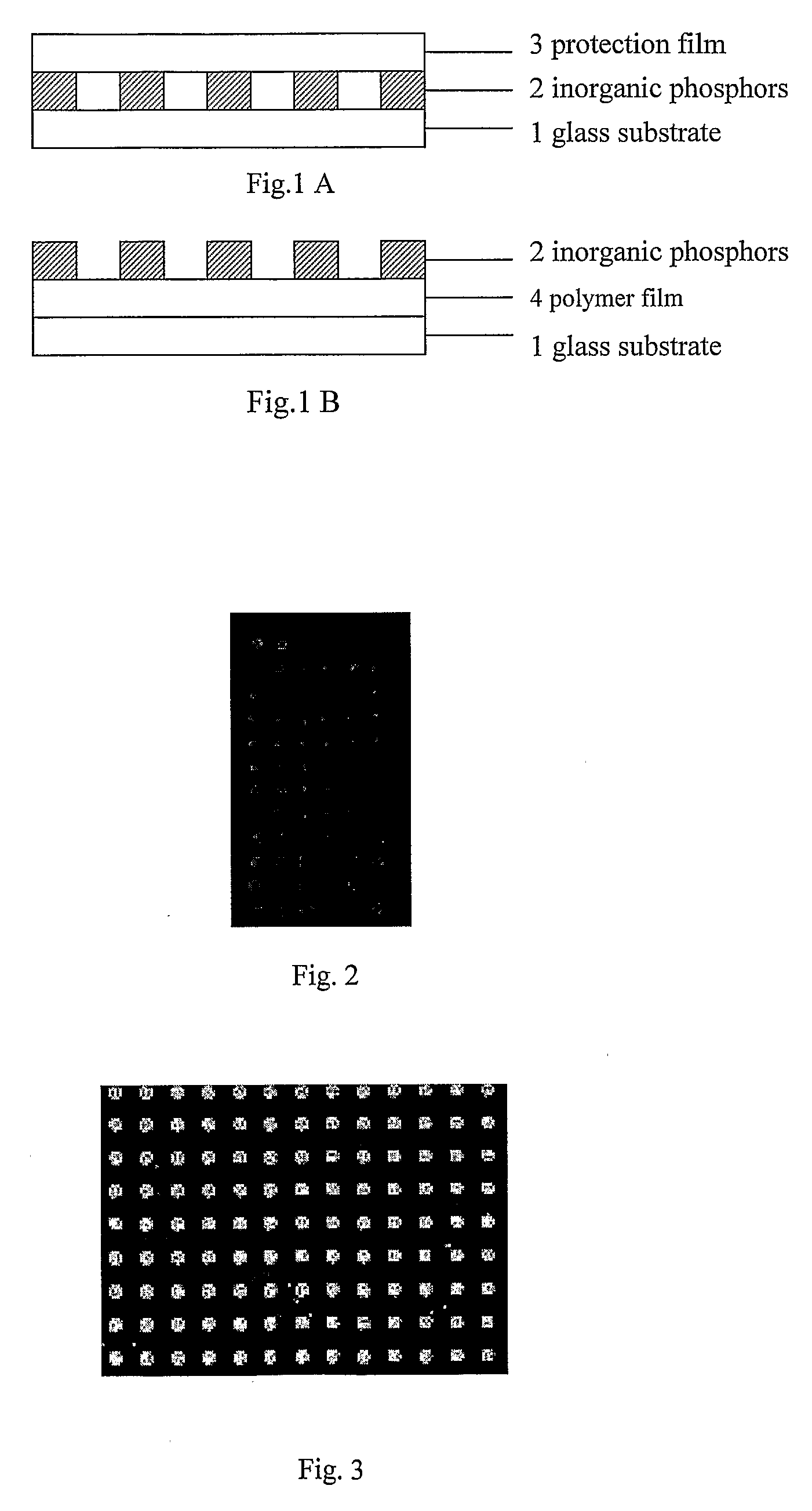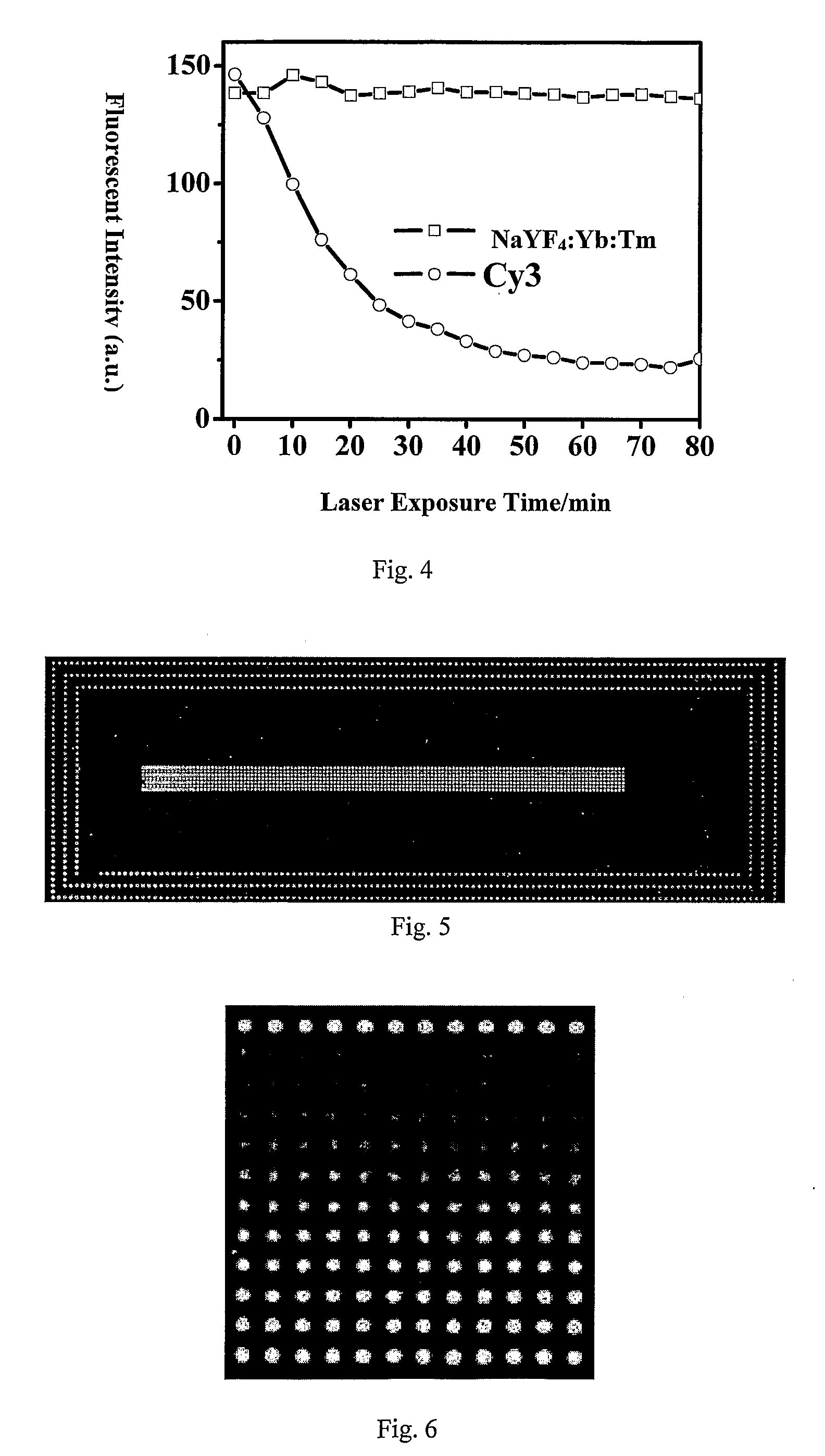Calibration slide for fluorescence detection instruments and process of preparation
a fluorescence detection and slide technology, applied in instruments, fluorescence/phosphorescence, chemical methods analysis, etc., can solve the problems of incomparable readings, error readings, application in quantitative microarray analysis, etc., and achieve the effect of long shelf life and high photostability of fluorescence detection instruments
- Summary
- Abstract
- Description
- Claims
- Application Information
AI Technical Summary
Benefits of technology
Problems solved by technology
Method used
Image
Examples
example 1
Preparation of Calibration Slides using Rare-Earth-SiO2 Complex as Fluorescing Material
[0034]1. Preparation of rare-earth-SiO2 complex
[0035]An aliquot of 2.2 ml of TEOS and 0.58 ml of anhydrous alcohol was mixed together and magnetically stirred in a 25 ml Erlenmeryer flask. Into the mixture, deionized water and 0.36 ml of 0.15 M hydrochloric acid aqueous solution was added dropwise to promote hydrolysis of TEOS. After reaction for 2 hours, a quantity of 10 ml of thulium chloride (TmCl3) solution was added. The gel was aged for 12 hours at room temperature. Tm—SiO2 complex was obtained after drying.
[0036]Four milligrams of the above said Tm—SiO2 rare-earth inorganic complex were added to 100 μL of 4% PVA aqueous solution. The mixture was sonicated till the particles were well dispersed and used as printing sample. GeneMachine Contact Arrayer was used to print the printing sample onto the surface of a clean microscope slide to produce the calibration slides.
[0037]The slide was scanne...
example 2
Preparation of Calibration Slides using Rare-Earth Complex NaYF4:Yb:Tm as Fluorescing Material
[0038]1. Preparation of NaYF4:Yb:Tm rare-earth complex
[0039]A sodium fluoride (NaF) solution was prepared by dissolving 2.1 g of NaF in 80 ml of deionized water. Solutions of 20 ml of 0.2 M Yttrium chloride (YCl3), 6 ml of 0.2 M ytterbium chloride (YbCl3) and 3 ml of 0.2 M TmCl3 were injected into the NaF solution. The mixture was stirred vigorously for 1 h at room temperature. The obtained precipitate was centrifuged at 4000 rpm, washed three times with deionized water, and dried at 60° C. The white powder of rare-earth complex was obtained after annealed at 400° C. for 5 h under nitrogen protection.
[0040]2. Preparation of calibration slide
[0041]The above said rare-earth complex was added to 10% Tween-20 aqueous solution. The calibration slides on clean glass slides were obtained following the same protocol as mentioned in Example 1.
example 3
Preparation of Calibration Slides using Rare-Earth Complex NaYF4:Tm as Fluorescing Material
[0042]1. Preparation of NaYF4:Tm rare-earth complex
[0043]A NaF solution was prepared by dissolving 2.1 g of NaF in 80 ml of deionized water. Solutions of 20 ml of 0.2 M YCl3 and 3 ml of 0.2 M TmCl3 were injected into the NaF solution. The mixture was stirred vigorously for 1 h at room temperature. The obtained precipitate was centrifuged at 4000 rpm, washed three times with deionized water, and dried at 60° C. The white powder of rare-earth complex was obtained after annealed at 400° C. for 5 h under nitrogen protection.
[0044]2. Preparation of aldehyde-modified slide
[0045]Five microscope slides were immersed in chromic acid solution (8 g K2Cr2O7+5 ml H2O+95 ml concentrated sulfuric acid) and cleaned thoroughly with Milli Q water. The slides were then immersed in 40 ml of 1% 3-aminopropyl triethoxysilane (APTES) ethanol solution for silanization. The reaction was continued for 1 h with rotation...
PUM
| Property | Measurement | Unit |
|---|---|---|
| diameter | aaaaa | aaaaa |
| diameter | aaaaa | aaaaa |
| thickness | aaaaa | aaaaa |
Abstract
Description
Claims
Application Information
 Login to View More
Login to View More - R&D
- Intellectual Property
- Life Sciences
- Materials
- Tech Scout
- Unparalleled Data Quality
- Higher Quality Content
- 60% Fewer Hallucinations
Browse by: Latest US Patents, China's latest patents, Technical Efficacy Thesaurus, Application Domain, Technology Topic, Popular Technical Reports.
© 2025 PatSnap. All rights reserved.Legal|Privacy policy|Modern Slavery Act Transparency Statement|Sitemap|About US| Contact US: help@patsnap.com



